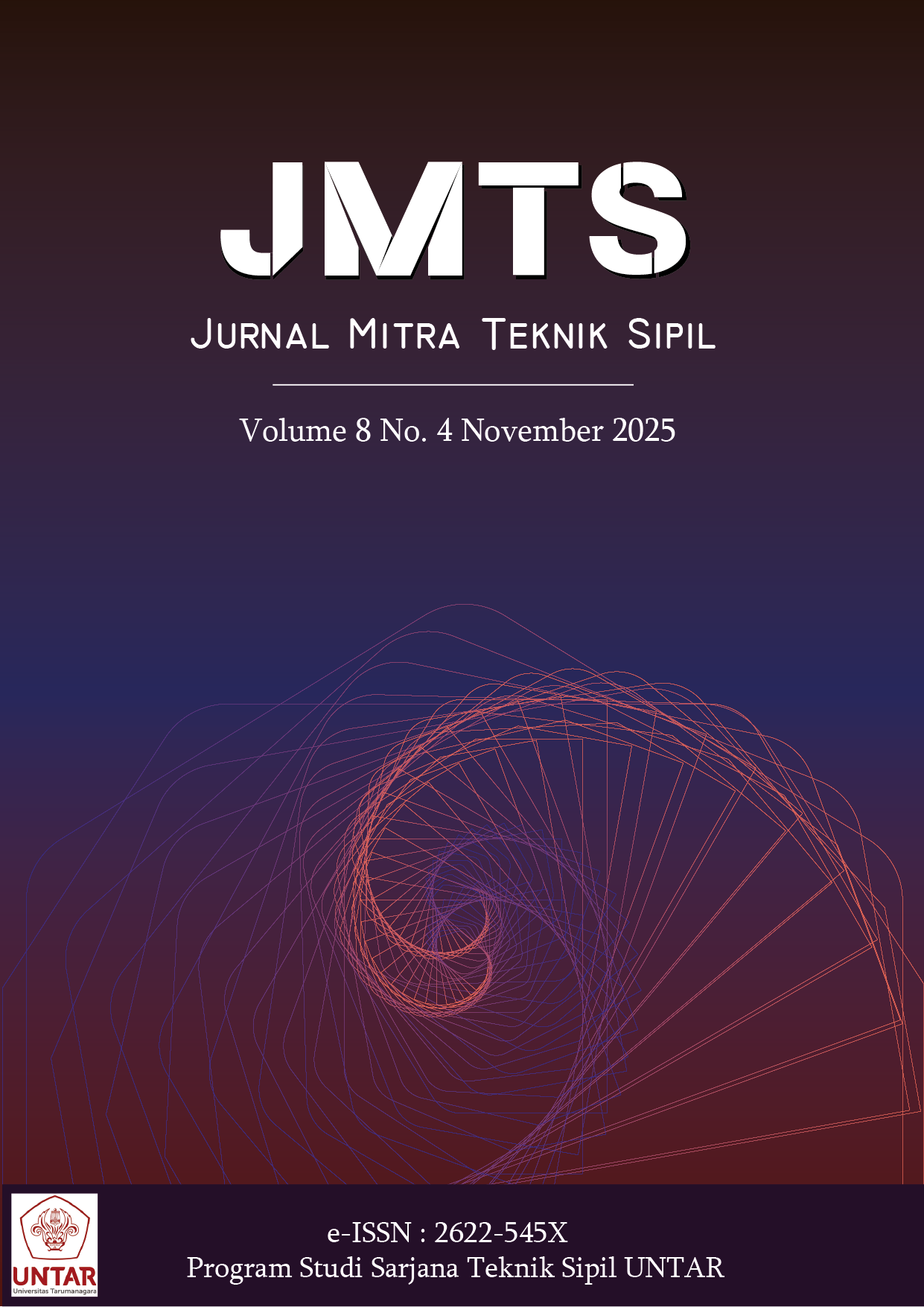PENGARUH SERAT TERHADAP TEGANGAN DAN REGANGAN PADA BETON TANPA AGREGAT KASAR
Main Article Content
Abstract
This research aims to obtain stress and strain diagram curves and analyze the amount of compressive force produced by fibrous concrete without coarse aggregate. This research uses the type of concrete RPC (Reactive Powder Concrete). RPC is a concrete innovation with materials that have small particle sizes to fill cavities in concrete and can increase the strength of the concrete. For this study, silica fume additives were used to produce concrete with better quality than concrete in general. This study began by using cylinder-shaped concrete samples with a diameter of 10 x 20 cm. After that, concrete compressive tests were carried out to obtain stress and strain diagram curves. This study is expected to obtain the results of total concrete compressive strength and stress strain diagram for fibrous concrete without coarse aggregate, because the provisions of ACI (American Concrete Institute) are only used for normal concrete. In this study, it was found that the actual curve was non-linear and the concrete samples that had been tested were not crushed into fragments because they were retained by the fibers. Based on the data analysis that has been carried out, the peak stress of the sample is obtained between 31 MPa and 66 MPa. The amount of energy that can be absorbed by concrete is between 0,0866 to 0,3418 with an average multiplying factor of 0,4989.
Abstrak
Penelitian ini bertujuan untuk medapatkan kurva diagram tegangan dan regangan (Stress Strain) dan menganalisis besar gaya tekan yang dihasilkan oleh beton berserat tanpa agregat kasar. Penelitian ini menggunakan jenis beton RPC (Reactive Powder Concrete). RPC merupakan inovasi beton dengan bahan material yang memiliki ukuran partikel kecil guna mengisi rongga-rongga pada beton dan dapat meningkatkan kekuatan daripada beton tersebut. Untuk penelitian ini digunakan bahan tambahan silica fume untuk menghasilkan beton dengan mutu yang lebih baik dibanding dengan beton pada umumnya. Penelitian ini dimulai dengan menggunakan sampel beton berbentuk silinder dengan ukuran diameter 10 x 20 cm. Setelah itu dilakukan tes tekan beton untuk mendapatkan kurva diagram tegangan dan regangan. Penelitian ini diharapkan dapat mendapatkan hasil total kuat tekan beton dan diagram tegangan regangan untuk beton berserat tanpa agregat kasar, dikarenakan ketentuan pada ACI (American Concrete Institute) hanya digunakan untuk beton normal. Dalam penelitian ini didapatkan kurva aktual bersifat non-linear dan sampel beton yang telah dilakukan pengetesan tidak hancur menjadi serpihan karena tertahan oleh serat. Berdasarkan analisis data yang telah dilakukan di peroleh peak stress sampel antara 31 MPa hingga 66 MPa. Besar energi yang dapat diserap oleh beton berada diantara 0,0866 hingga 0,3418 dengan rata-rata faktor pengali sebesar 0,4989.
Article Details

This work is licensed under a Creative Commons Attribution-NonCommercial-ShareAlike 4.0 International License.
This work is licensed under Jurnal Mitra Teknik Sipil (JMTS) Creative Commons Attribution-ShareAlike 4.0 International License.References
Achmad Ihza Mahendra, Nurul Rochmah, & Herry Widhiarto. (2023). Pengaruh penggunaan silica fume sebagai bahan tambah pada beton alir. Student Scientific Creativity Journal, 1(4), 493–502. https://doi.org/10.55606/sscj-amik.v1i4.1577
Christianto, D., Utami, T. A., & Yoana, M. (2023). Sifat mekanik beton tanpa agregat kasar. JMTS: Jurnal Mitra Teknik Sipil, 6(1), 145-158. https://doi.org/10.24912/jmts.v6i1.21637
Imam, E., As’ad, S., & Basuki, A. (2015). Kinerja beton serat menggunakan uji toughness panel pada kandungan serat yang berbeda. Matriks Teknik Sipil, 3(3), 712-719. https://doi.org/10.20961/mateksi.v3i3.37270
Kurniati, D. (2024). Ketahanan kuat tekan beton serat fiber glass sebagai bahan tambah. Jurnal Karkasa, 10(2), 39-44. https://doi.org/10.32531/jkar.v10i2.898
Mindess, S., & Bentur, A. (2006). Fibre Reinforced Cementitious Composites (2nd ed.). CRC Press LLC. https://doi.org/10.1201/9781482267747
Perceka, W., Djayaprabha, H. S., & Rizkiani, S. N. (2022). Aplikasi high performance fiber reinforced concrete sebagai material berkelanjutan: ikhtisar. Journal of Sustainable Construction, 1(2), 33-42. https://doi.org/10.26593/josc.v1i2.5275
Tjokrodimuljo, K. (2007). Teknologi Beton. Biro Penerbit KMTS FT UGM.
Badan Standardisasi Nasional. (2019). Persyaratan Beton Struktural Untuk Bangunan Gedung (SNI 2847:2019). http://sispk.bsn.go.id/SNI/DaftarList
Tjokrodimuljo, K. (2007). Teknologi Beton. Biro Penerbit KMTS FT UGM.
Tripamungkas, A. D. (2023). Analisis tegangan regangan pada balok beton bertulang menggunakan metode elemen hingga. Indonesian Journal of Civil Engineering Education, 9(2), 34-37. https://doi.org/10.20961/ijcee.v9i2.83603
Wight, J. (2015). Reinforced Concrete Mechanics and Design. Pearson Education



